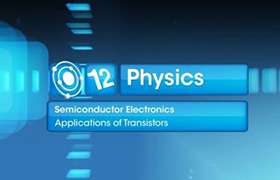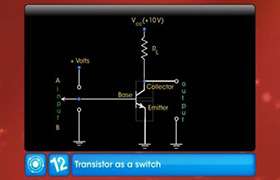CBSE Class 12-science Answered
Please explain the derivation of the expressions for voltage gain and the application of those formulae.
Thank You.
Asked by damarlasumanjali | 30 Aug, 2015, 05:23: PM
Dear damarlasumanjali@gmail.com
Thanks for asking us a question in Ask the Expert section of TopperLearning.com.
The derivation of voltage gain for transistor as an amplifier can be found as is in the textbook.
Kindly refer to NCERT-XII-Part II textbook page numbers 497 and 498 for the same.
If however, you have doubt about certain step in the derivation, then you may post it on our site. We will be happy to help you.
The application of these formulae is simply to identify by how much that transistor can amplify the nput signal. It can be used in any device like loudspeaker, radio, etc where amplification is needed.
Regards
Topperlearning Team.
Regards
Topperlearning Team.
Answered by Romal Bhansali | 30 Aug, 2015, 06:25: PM
Concept Videos
CBSE 12-science - Physics
Asked by Www.harshalhire51 | 20 Nov, 2019, 09:48: PM
CBSE 12-science - Physics
Asked by Topperlearning User | 10 Jul, 2014, 02:24: PM
CBSE 12-science - Physics
Asked by Topperlearning User | 24 Jun, 2014, 02:36: PM
CBSE 12-science - Physics
Asked by Topperlearning User | 01 Jul, 2014, 10:01: AM
CBSE 12-science - Physics
Asked by Topperlearning User | 10 Jul, 2014, 02:32: PM
CBSE 12-science - Physics
Asked by Topperlearning User | 10 Jul, 2014, 02:06: PM
CBSE 12-science - Physics
Asked by Topperlearning User | 10 Jul, 2014, 01:52: PM
CBSE 12-science - Physics
Asked by Topperlearning User | 10 Jul, 2014, 03:03: PM
CBSE 12-science - Physics
Asked by Topperlearning User | 01 Jul, 2014, 10:48: AM
CBSE 12-science - Physics
Asked by Topperlearning User | 04 Jun, 2014, 01:23: PM




 The adjoining figure shows a common emitter transistor amplifier which uses a silicon transistor. If the quiescent emitter current is 1 mA what is the base biasing voltage?
The adjoining figure shows a common emitter transistor amplifier which uses a silicon transistor. If the quiescent emitter current is 1 mA what is the base biasing voltage?